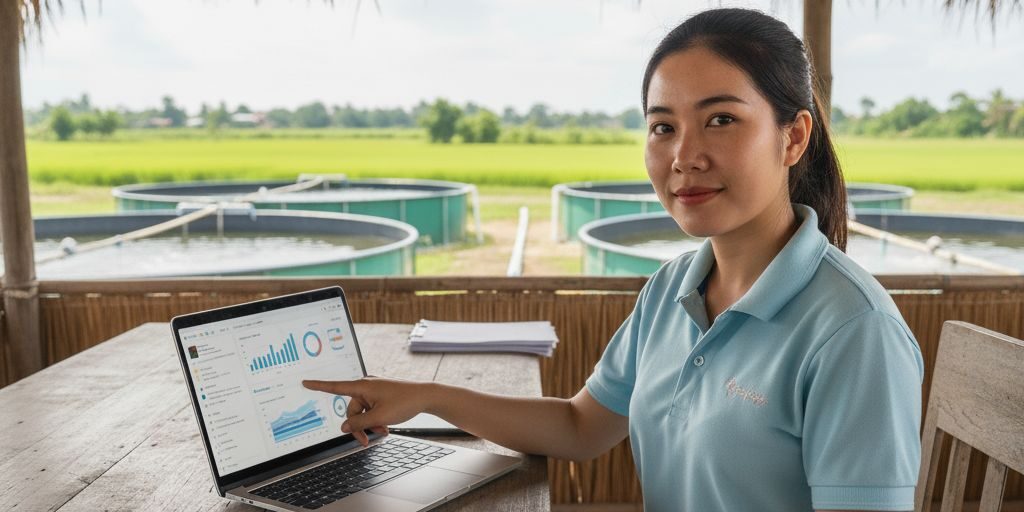- Software Gestor para Aquicultura
- (85) 2139-6730
- contato@despesca.com.br
Correct Pricing for Aquaculture: Calculate Your Fish and Shrimp Prices

10 Essential Precautions During Fish Harvesting to Ensure Seafood Quality
02/10/2025
10 Promising Aquaculture Market Niches: Innovation and Profitability
07/10/2025Correct pricing of fish and shrimp is one of the biggest challenges for aquaculture producers, being a decisive factor for the financial health and sustainability of the business. An incorrectly calculated price can mean the difference between profit and loss, even with high-quality production. Therefore, to ensure profitability, it is essential to go beyond a simple “market price” and adopt a strategy that considers production costs, market dynamics, and opportunities for added value.
This process doesn’t have to be complex, but it requires organization and an analytical look at all stages of the production cycle. By mastering these three pillars—costs, market, and value—producers gain control over their profit margin and position their product more competitively.
The Starting Point: Detailed Calculation of Production Costs
First and foremost, for correct pricing, it is crucial to thoroughly understand the costs involved in production. Ignoring any expense, no matter how small, leads to a distorted view of actual profitability. Costs are generally divided into two main categories:
- Fixed Costs: These do not vary with the volume of production. They include, for example, administrative salaries, rent, depreciation of equipment and structures (ponds, aerators, vehicles), fixed taxes, and licenses. Depreciation, often overlooked, should be calculated by dividing the asset’s value by its useful life, ensuring that future replacement is provisioned.
- Variable Costs: These are directly linked to the quantity produced. The heaviest item here is undoubtedly feed, which can represent more than 70% of the operational cost. Besides feed, this category includes post-larvae or fingerlings, electricity for pumping and aeration, temporary labor, medications, probiotics, and water treatment inputs.
The Total Production Cost is the sum of fixed and variable costs. From this, the cost per kilogram (Total Cost ÷ Total Biomass Produced in kg) is calculated, which is the absolute minimum value at which the product must be sold to avoid a loss.
Analyzing the Scenario: Market Dynamics
With the cost per kilogram in hand, the next step is to look outside the farm. Market analysis prevents your price from being disconnected from reality, whether it’s too high (driving away buyers) or too low (missing potential earnings). Therefore, some points should be observed:
- Competitor Prices: Investigate the prices charged by other producers in your region for products of similar quality. This doesn’t mean you should copy their prices, but rather use this information as a benchmark.
- Demand and Seasonality: Fish consumption increases during periods like Easter and year-end, which may allow for higher prices. Similarly, understanding consumer preferences (e.g., the growing demand for healthy and convenient foods) helps to position the product.
- Distribution Channels: The selling price for processing plants, distributors, restaurants, or directly to the final consumer varies significantly. Each channel has a negotiation margin and distinct requirements that impact price formation. Explore Distribution Channels for Shrimp and Fish Farming (Note: This link points to the Portuguese version as no English equivalent was provided) to understand which best suits your business.
Differentiation and Profitability: The Added Value Strategy
Selling only in natura fish or shrimp can limit your profit margins, making you more susceptible to commodity market fluctuations. On the other hand, adding value allows you to differentiate yourself and justify a higher price. This strategy involves offering the customer something more than the basic product.
Consider investing in processing, such as selling fillets, steaks, gutted fish, or peeled shrimp. Pre-cooked products, skewers, or even fish burgers meet a demand for convenience. Beyond processing, added value can come from other factors, such as:
- Packaging: Vacuum packaging, which extends shelf life and improves presentation, is perceived as a quality differentiator.
- Certifications and Quality Seals: Sustainability or good management practice seals can attract a niche of consumers willing to pay more for a responsible product.
- Brand and Marketing: Building a strong brand, with an online presence and telling the story of your production, creates a connection with the consumer, who begins to value the origin and quality of your fish. To delve deeper, see How to Add Value to Your Product and Conquer New Markets (Note: This link points to the Portuguese version as no English equivalent was provided).
Technology as an Ally in Correct Pricing
Performing all these calculations and analyses manually is an arduous and error-prone task. The use of management software, such as Despesca, is a game-changer for the modern producer.
Specialized systems automate the recording of all costs, from feed purchases to energy consumption per pond. They allow for the real-time calculation of production cost per kilogram, providing precise data for decision-making. Furthermore, with inventory control and sales records, the software generates detailed financial reports, showing the actual profit margin of each batch and helping to identify the most profitable sales channels.
In summary, defining the selling price is a strategic decision that balances internal cost knowledge with market intelligence and the future vision of your business. By integrating these three pillars, with the support of technology, the producer ceases to be a mere price-taker and becomes the protagonist of their profitability.




